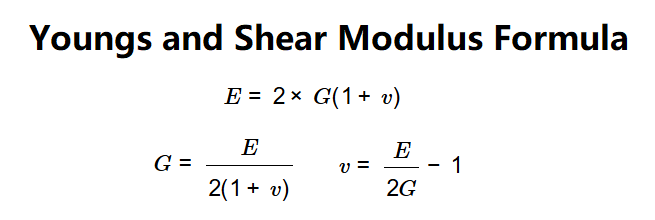 Home
Home
 Back
Back

Definition: This calculator computes the relationship between Young's modulus (\( E \)), shear modulus (\( G \)), and Poisson's ratio (\( v \)) for isotropic and homogeneous materials, using the equation \( E = 2 \times G (1 + v) \).
Purpose: It is used in material science and engineering to determine one of these parameters when the other two are known, aiding in the design and analysis of materials under stress.
The calculator uses the following equation:
Formula: \[ E = 2 \times G (1 + v) \] Rearranged forms:
Unit Conversions:
Steps:
Calculating these parameters is crucial for:
Example: Calculate the Young's modulus (\( E \)) for a material with a shear modulus (\( G = 30 \, \text{GPa} \)) and Poisson's ratio (\( v = 0.3 \)).
Q: What is the relationship between Young's modulus, shear modulus, and Poisson's ratio?
A: For isotropic and homogeneous materials, they are related by the equation \( E = 2 \times G (1 + v) \), where \( E \) is Young's modulus, \( G \) is the shear modulus, and \( v \) is Poisson's ratio.
Q: Why is Poisson's ratio typically between -1 and 0.5?
A: Poisson's ratio measures the lateral strain relative to the longitudinal strain. For most materials, it is positive (0 to 0.5), indicating that they contract laterally when stretched longitudinally. Negative values (down to -1) are possible for auxetic materials, which expand laterally when stretched.
Q: How are Young's modulus and shear modulus used in real life?
A: They are used in engineering to design materials and structures that can withstand tensile and shear stresses, such as in bridges, aircraft, and machinery, ensuring safety and performance under load.